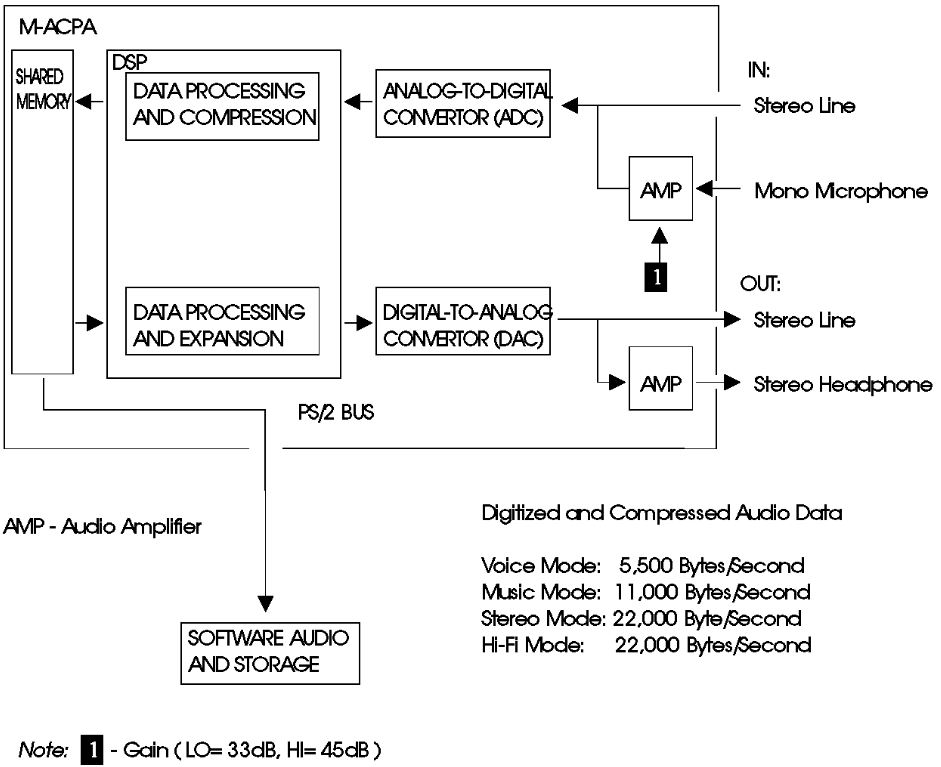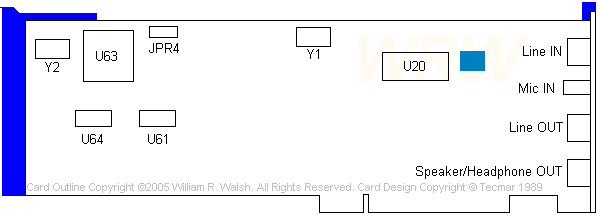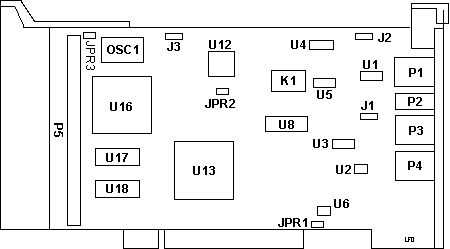|
@6e6c.adf M-ACPA/A MACPA.DGS M-ACPA Diagnostics ACPADIAG.EXE DOS based M-ACPA Diagnostics Audiocap.exe ACPA
Adapter/A Option Disk (720K! Use FORCEDOS under
NT) Or use Wild Bill's ZIP of the
extracted files HERE IBM M-ACPA Win. driver Corrective Serv. IBM M-ACPA Audio
Application Programming Interface Functional
Description "C" TMS320 Family Development Support Reference Guide TMS320C2x User's Guide TMS320C2x DSP Programmers Reference Card 190-159 M-Audio Capture And Playback Adapter/A Upgrade Kit 189-101 ACPA for PS/2, ACPA/A for PS/2, and VCA/A for PS/2 Installing the M-ACPA under Win95 (Peter Wendt) IBM M-Audio Capture & Playback Adapter/A (M-ACPA) @6E6C (William Walsh) "Virtual device driver for
M-Audio Capture and playback Adapter"
DOS/Win3.1x/OS2 ACPA, ver A JPR4 ACPA, ver B ACPA, ver C (Ultimedia) Win95 Experiences (William Walsh) SoundBlaster Support (William Walsh and Christian Holzapfel) M-ACPA Installation Files, Peter and VDD for M-ACPA ACPA Construction ACPA Source ADF Sections ACPA Block Diagram (Extract from US Patent 5,054,360)  Functional Diagram  The M-ACPA has audio input jacks for both microphone and line. The difference is that the microphone jack is connected to an amplifier to boost the signal. The output of most external audio devices is suitable for the line-input. A signal from an analog audio source is digitized by the analog-to-digital converter. The digitized signal is compressed to save storage and is stored in the M-ACPA shared memory. MMPM/2 reads the shared memory and stores the audio in the PS/2 memory. ACPA (Rev. A) Thanks to William Walsh for outlining this and doing the chip ID. 
Y1 - 22.5792MHz
(probably for CS5126 external clock -- see datasheet) A-5W-K “A series” miniature relay 2 poles—1 to 2 a (for
signal switching) Datasheet
Jumper JPR4
ACPA (Rev. B) P/N 95F1288 Made by Rexxon/Tecmar FCC ID ANOMACPAMC 
U1, 3, 5 NS LF347M Quad operational amplifier (JFET) Datasheet U2 NS LM386 Low Voltage Audio Power Amp, Mono Microphone In Datasheet U6 NS LM386 Low Voltage Audio Power Amp, Stereo Headphone Datasheet U4 Intersil DG211CY SPST 4-Channel Analog Switch Datasheet U8 NEC D6355G (uPD6355G) 16-Bit Digital-to-Analog Converter Datasheet U12 Crystal Semi CS5126-KL 16-bit stereo A/D converter for digital audio Datasheet U16 TI TMS320C25FNL DSP Datasheet HERE K1 A-5W-K “A series” miniature relay 2 poles—1 to 2 a (for signal switching) Datasheet
JPR3- Artifact
Leave jumpered. Why this is, I don't know. 23 March 2019 - After researching the TMS320 DSP, I saw
the block diagram for a TMS320C50 development kit. That
30 pin artifact is for an I/O Expansion Connector.
Remember, the ACPA is not just a simple audio card, but
instead is an advanced signal processing adapter. The
Audiovation is a cheaper audio card [with MWAVE
technology]. I hope to find the pinout for the expansion
connector...
ACPA (Ultimedia Rev. C) 
U12 Crystal
CS5126-JL (16 bit stereo A/D converter, datasheet here) U6 - DG211CY SPST 4
Channel Analog Switch (Switches ±15V Analog Signals) Datasheet TL084C JFET-Input
Quad Operational Amp Datasheet
NOTE: No visible
component IDs T1-7 TDK ZJYS-2
(ZJYS51R5-2P) Common-Mode Choke Coils for Signal Line Datasheet P4
Pinout = Multimedia Port (same as
Audiovation) NOTE: Odd # pins
top, Even # pins bottom
I have the M-ACPA in various machines - one of them is a Server 85 (33MHz planar) with Kingston Turbochip 586-133 installed. Works nice. But: Apart from that it works pretty good and
the audio quality is a lot better compared to ISA-sound
card. The digitizer part (analog in) is 10X-better than
on any other ISA-card due to the better signal / noise
ratio of the MCA. I use one ACPA to digitize my old
analog records. Windows 95 Experiences (set-up procedure here.) The M-ACPA sounds pretty darn good when playing waveform audio. The MIDI implementation doesn't sound at all good under Windows 95. Some notes seem to be over-emphasized and others you can barely hear. Some wave sounds come through a bit strangely and others play fine. I can't explain that. This might be compression related. As with Audiovation, using 16 bit programs is your best bet for proper sound playback. Most 32 bit programs won't even see that you have the ACPA installed. I didn't try recording from any source. Warning: You get no volume control on the ACPA that I can see. It looks to me as though the outputs are "full on" under Windows 95. For your ears' sake, use earphones or speakers that have an inline volume control. MP3 files played nicely on my 9585-0XF
using an old 16-bit version of Fraunhofer's MP3 decoder
software and a Kingston 133MHz TurboChip CPU upgrade. To
multitask I had to turn down the decoding quality a bit.
You'd be hard pressed to hear the difference from
ordinary computer speakers though. Sound Blaster Support? Pulled from William Walsh HERE Yes, in at least some sense of the term. Christian Holzapfel turned on the unobtainium mill and cranked this out: Yes, it is true! While sorting my floppy disks I found one named "Virtual device driver vor M-Audio Capture and playback Adapter", which came with my 9577-STG a few years ago. However, I uploaded the content to http://holz.darktech.org/stuff/macpavdd.rar so everyone can experience this. [ed. original file location is DEAD] These are the magic files:
It needs to be installed manually, just read the appropriate file, "README.WIN" in most cases; WININST.BAT only does half of the job, so don't care about it. The emulation only works within a Windows DOS session, so the DOS driver seems useless to me. It is designed for Windows 3.1, but it also works under Windows 98 SE, I tested them both successfully. There mustn't be any other MACPA driver installed, not even the great one with the .inf from Peter. However, after you installed this one, sound works great within Windows too, although you don't see a device in the device manager. There are not less than 4 readme files in the package, and useful information is spread all over: "The VDD will allow you to run most SoundBlaster and MPU-401/MT32 or LAPC applications within a Windows DOS session. Do NOT run the SVAUDIO.EXE. The VDD will attempt to map the sounds requested by the application to the nearest M-ACPA sound. In most cases this is quite acceptable, but in any case it will sound different." [README.WIN / README.OS2] "If you turn music on for SoundBlaster support and specify port 240, music comes out great." [MAUDIO.TXT] "(3) The M-ACPA must be set to Interrupt 5 for the SoundBlaster emulation to have any chance of working. Otherwise, it may lock up your machine." [MAUDIO.TXT] So, if you configure your DOS sound application (a.k.a. "game") to Int 5, I/O 240, everything works fine. If you need to specify a DMA channel, well... I locked up my '95 on every try. The reasons for this are clear, the MACPA simply doesn't need/support a DMA channel. I tried "DOOM" without SFX and "Skyroads" with SFX, they both work, and the music themes are recognizable, but still sound a bit strange. Why this is, I can't say. One more thing I noticed, all the files on the disk are dated later than the ones on any MACPA option/driver package. If you run "Audiover.exe" from the M-ACPA Win driver Corrective Service disk, it tells you the installed driver only supports up to 22.050kHz, Mono, 8-bit. If this is true, I cannot say. It doesn't sound that bad, but this is just my perception. It looks to be an unfinished, unofficial driver set, since I could not find any information about it anywhere. Finally, the README.DOS says: "Error handling is not very robust at this time. Be prepared to reboot." :-) I had no problems so far, however. What you need is here. (ZIP format!) It should be said that this is beta quality software (if that much!) and it may do Bad Things to your system. M-ACPA Installation Files, Peter and VDD for M-ACPA
ACPA Construction Brad Parker said: I know Audiovation sounds really good, and specs out good to, but I'm working on an audio related project that needs to run under Linux, so the ACPA series cards are my only real choice, unless you know of a OSS compatible Audiovation driver for Linux. I Looked at both the M-ACPA/A and ARPA audio stages tonite and they are functionally identical (Think you said that on your page). Four small transistors near the center are for the Microphone gain stage and are probably acting as an impedance matching circuit, the two small transistors near the top act as buffers for the line in stage. Three additional gain blocks are made up of the three quad operational amplifiers marked TL084C, the C being CMOS. These are low noise, hi impedance devices that use bi-fet transistor technology internally. Each TL084 contains four Op-Amp devices. Generally they sound good and can be considered an "upgrade" part. The "speaker" outputs, and I use that term loosely, are powered by two LM386 power Op-Amps. They will drive headphones, but are not known for their fidelity. They could be bypassed, yielding a second set of line outputs. I'll poke around with an oscilloscope but I think the spot where the inputs come in through the coupling capacitors, marked C35 and C36 on M-ACPA and C15 and C17 on ARPA, looks likely. I just noticed that ARPA only has 3 voltage regulators, while M-ACPA has 4. The LM 317 and LM 337 imply a dual rail power supply with a positive and a negative rail on the M-ACPA, while ARPA appears single ended. This could mean that M-ACPA has more dynamic range, greater output levels and less TIM distortion than ARPA. The 317/337 pair are adjustable, so I don't know what their output voltage is, but if I designed the thing, I'd tap the +/- 12 volt and regulate it 10 or 11 volts. ACPA
Source ACPA works a lot like Mwave, in that there
is a TI DSP that it is loaded with an operating system
(ACPA OS?). This indicates that Mwave followed IBM's
usual evolutionary, not revolutionary model. The ACPA OS runs the programs that play,
record and loopback. Dave Weis ported the OS and it
loads and runs the playback program he also ported.
There is only 8K of memory on it, so I don't think a
Soundblaster emulation like Mwave's is possible. I'm
going to add record capability by porting the record
program module. The card doesn't use interrupts, it reads
and writes directly to I/O ports, MCA superiority at
work. Looks like it can be treated as a block device
which means that direct DAT record/playback (ala SGI) is
possible. That's a job for whoever supports the mt
utility. The ACPA supports just about every sample
rate I can think of, including a 48K professional format
that was used with M-motion and would probably work with
DAT and ADAT. ACPA also supports a mono 88K rate, which
would make very good quality recordings. The only major
one missing is the current 96K fad. Of course we are
only recording with 16 bit resolution, not 20 or 24 bit
like the modern stuff. Then again, they have to down
convert to put it on a 16 bit CD. I read on the Pro
Audio NG that bit rate and sample rate conversion is a
big pain. The consensus there is to record at the sample
rate and resolution of your target media, 16 bit 44.1
Khz, or for commercial reproduction, 16 bit 48 Khz
I think the most interesting thing I
found out is that the original IBM driver supports up to
4 ACPAs concurrently! Keeps track of the separate stereo
audio streams and everything. Very nice for my purposes.
Don't think OS/2 every took advantage of that. Hopefully
the Linux stuff will work out that way :-) If I can pull this off, I'm going to
attempt a port for Audiovation. I finally got a copy of
the Mwave developer's kit. It's very Win 3.XX
orientated, but the Soundblaster emulator might be
ported to work with Linux directly, without all the dual
boot monkey business that goes on now. AdapterId 06e6c "ACPA/A" Address Selection Interrupt Selection
|
|||||||||||||||||||||||||||||||||||||||||||||||||||||||||||||||||||||||||||||||||||||||||||||||||||||||||||||||||||||||||||||||||||||||||||||||||||||||||||||||||||||||||||||||||||||||||||||||||||||||||||||||||||||
 This is the only way to
jumper it. Experiment if you are curious.
This is the only way to
jumper it. Experiment if you are curious. 